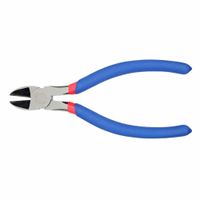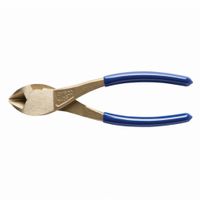Call +(254) 703 030 000 / 751 483 999 / 721 704 777
- Home
- Tools
- Hand Tools
- Pliers
- Diagonal Cutting Pliers
.....Read More
Frequently Asked Questions
What are diagonal-cutting pliers used for?
Diagonal-cutting pliers, often referred to as diagonal pliers or wire cutters, are primarily used for cutting wire and small pins in areas that are difficult to reach with other types of cutting tools. The cutting edges of these pliers are set at an angle, which allows them to cut flush with a surface, making them ideal for trimming excess wire in electrical work, jewelry making, and crafting.
These pliers are commonly used by electricians, as they can efficiently cut through copper, brass, iron, aluminum, and steel wire. They are also useful for cutting cable ties, removing nails, and trimming plastic components. The angled design of the cutting edges provides a clean cut without crushing the material, which is essential in preventing damage to the surrounding area or the material being cut.
In electronics, diagonal-cutting pliers are used to snip off component leads on circuit boards, ensuring a neat and tidy finish. In automotive work, they can be used to cut through zip ties and other fasteners. Additionally, they are often employed in household tasks, such as cutting picture wire or trimming floral stems.
The handles of diagonal-cutting pliers are typically insulated to provide a comfortable grip and to protect the user from electrical shock when working with live wires. The tool's compact size and precise cutting ability make it a versatile and essential tool in various professional and DIY toolkits.
How do you maintain diagonal-cutting pliers?
To maintain diagonal-cutting pliers, follow these steps:
1. **Cleaning**: After each use, wipe the pliers with a clean, dry cloth to remove dirt, debris, and any residue. For stubborn grime, use a mild detergent with water and a soft brush, then dry thoroughly.
2. **Lubrication**: Apply a few drops of light machine oil or a specialized tool lubricant to the pivot joint. Open and close the pliers several times to distribute the oil evenly, ensuring smooth operation.
3. **Rust Prevention**: Store the pliers in a dry place to prevent rust. Consider using a rust inhibitor spray or a silica gel pack in the storage area to absorb moisture.
4. **Sharpening**: If the cutting edges become dull, use a fine file or sharpening stone to restore sharpness. Carefully file along the beveled edge, maintaining the original angle, and avoid over-sharpening to prevent damage.
5. **Inspection**: Regularly inspect the pliers for signs of wear, such as nicks or chips in the cutting edges, and check the alignment of the jaws. Misaligned jaws can be adjusted by gently tapping them with a mallet.
6. **Handle Care**: Ensure the grips are intact and not slipping. Replace worn or damaged grips to maintain a secure hold and prevent accidents.
7. **Proper Use**: Use the pliers only for their intended purpose—cutting wires and small fasteners. Avoid using them on hardened materials or as a hammer, which can damage the tool.
By following these maintenance steps, you can extend the lifespan of your diagonal-cutting pliers and ensure they remain effective and safe to use.
What is the difference between diagonal-cutting pliers and side cutters?
Diagonal-cutting pliers and side cutters are often terms used interchangeably, but they can have subtle differences depending on context and regional terminology.
Diagonal-cutting pliers, commonly referred to as "diagonal cutters" or "dikes," are designed with cutting edges that are set at an angle, typically around 15 to 20 degrees. This angled design allows for a flush cut, making them ideal for cutting wire, pins, and other small materials close to a surface. They are widely used in electrical work, jewelry making, and other applications where precision cutting is required.
Side cutters, on the other hand, generally refer to pliers with cutting edges that are aligned with the handles, providing a more straightforward cutting action. They are also used for cutting wire and similar materials but may not offer the same level of precision for flush cuts as diagonal cutters. Side cutters are often used in general-purpose applications where the angle of the cut is less critical.
In summary, while both tools serve similar functions, diagonal-cutting pliers are typically preferred for precision work due to their angled cutting edges, whereas side cutters are used for more general cutting tasks. The distinction can vary based on regional preferences and specific tool designs.
Can diagonal-cutting pliers cut through nails and screws?
Diagonal-cutting pliers are primarily designed for cutting wire and small pins, not for cutting through nails and screws. While they can cut through soft materials like copper or aluminum wire, they are generally not suitable for cutting harder materials such as nails and screws, which are often made of steel. Attempting to cut nails or screws with diagonal-cutting pliers can damage the tool, dull the cutting edges, or even cause the pliers to break. For cutting nails and screws, it is recommended to use tools specifically designed for such tasks, like bolt cutters or a hacksaw.
Are insulated diagonal-cutting pliers necessary for electrical work?
Yes, insulated diagonal-cutting pliers are necessary for electrical work. They provide critical safety features that protect electricians from electrical shock. These pliers are designed with non-conductive materials, typically rated to withstand up to 1,000 volts, ensuring that the user is insulated from live electrical circuits. This is crucial when working in environments where accidental contact with live wires is possible.
The insulation on these pliers is usually made from high-quality rubber or plastic, which not only prevents electrical conduction but also offers a comfortable grip, reducing hand fatigue during prolonged use. This ergonomic design is important for precision and control, especially in tasks that require cutting wires in tight or awkward spaces.
Moreover, diagonal-cutting pliers are specifically designed for cutting wires, cables, and small pins, making them an essential tool in an electrician's toolkit. Their sharp, angled blades allow for clean cuts without fraying the wire ends, which is important for maintaining the integrity of electrical connections.
Using non-insulated tools in electrical work poses significant risks, including electrical shock, burns, or even fatal accidents. Therefore, adhering to safety standards and using insulated tools is not just a best practice but a necessity in the electrical industry. Insulated diagonal-cutting pliers are a fundamental component of this safety protocol, ensuring both the safety of the electrician and the reliability of the electrical system being worked on.
How do you choose the right size of diagonal-cutting pliers?
To choose the right size of diagonal-cutting pliers, consider the following factors:
1. **Application**: Determine the specific task. For electronics or jewelry work, smaller pliers (4-5 inches) are ideal for precision. For general electrical work or cutting thicker wires, larger pliers (6-8 inches) are more suitable.
2. **Material**: Consider the material you will be cutting. For soft wires, smaller pliers suffice. For harder materials like steel, larger pliers with hardened cutting edges are necessary.
3. **Leverage and Force**: Larger pliers provide more leverage, making it easier to cut through thicker materials with less effort. Smaller pliers require more manual force for the same task.
4. **Space Constraints**: In tight spaces, smaller pliers offer better maneuverability. Larger pliers may be cumbersome in confined areas.
5. **Hand Size and Comfort**: Choose pliers that fit comfortably in your hand. Ergonomic handles reduce fatigue during prolonged use. Test the grip to ensure it feels secure and comfortable.
6. **Quality and Durability**: Opt for pliers made from high-quality materials like chrome vanadium steel for durability. Check for features like induction-hardened cutting edges for longer life.
7. **Brand and Price**: Reputable brands often offer better quality and warranty. Balance cost with the frequency and intensity of use.
8. **Safety Features**: Look for features like insulated handles if working with electrical components to prevent shock.
By evaluating these factors, you can select the appropriate size of diagonal-cutting pliers that best suits your needs, ensuring efficiency and safety in your tasks.
What materials are diagonal-cutting pliers made from?
Diagonal-cutting pliers are typically made from a combination of durable materials to ensure strength, longevity, and effective cutting performance. The primary materials used include:
1. **High-Carbon Steel**: This is the most common material for the jaws and cutting edges. High-carbon steel is known for its hardness and ability to maintain a sharp edge, making it ideal for cutting through wires and other materials.
2. **Chrome Vanadium Steel**: Often used for enhanced durability, chrome vanadium steel provides additional strength and resistance to wear and tear. It is also resistant to corrosion, which is beneficial for tools exposed to various environments.
3. **Alloy Steel**: Some diagonal-cutting pliers are made from alloy steel, which combines different metals to enhance specific properties like toughness and resistance to impact and deformation.
4. **Stainless Steel**: While less common for the cutting edges due to its softer nature compared to high-carbon steel, stainless steel is sometimes used for its excellent corrosion resistance, especially in environments where rust is a concern.
5. **Coatings and Finishes**: To further enhance durability and resistance to corrosion, diagonal-cutting pliers may have additional coatings such as black oxide, nickel, or chrome plating. These finishes also reduce friction and improve the tool's overall lifespan.
6. **Handles**: The handles are typically made from materials like rubber, plastic, or thermoplastic elastomers. These materials provide a comfortable grip, reduce hand fatigue, and offer electrical insulation for safety when working with live wires.
These materials are selected to ensure that diagonal-cutting pliers can withstand the mechanical stresses of cutting and provide reliable performance over time.


